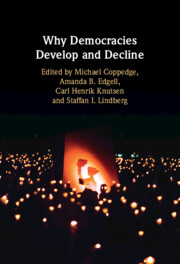Book contents
- Why Democracies Develop and Decline
- Why Democracies Develop and Decline
- Copyright page
- Contents
- Figures
- Tables
- Tables in Appendices
- Acknowledgements
- 1 V-Dem Reconsiders Democratization
- 2 The Ups and Downs of Democracy, 1789–2018
- 3 Long-Run Factors
- 4 International Influence
- 5 Economic Determinants
- 6 Political Institutions and Democracy
- 7 Democracy and Social Forces
- 8 Causal Sequences in Long-Term Democratic Development and Decline
- Appendices
- Bibliography
- References
Bibliography
Published online by Cambridge University Press: 28 June 2022
- Why Democracies Develop and Decline
- Why Democracies Develop and Decline
- Copyright page
- Contents
- Figures
- Tables
- Tables in Appendices
- Acknowledgements
- 1 V-Dem Reconsiders Democratization
- 2 The Ups and Downs of Democracy, 1789–2018
- 3 Long-Run Factors
- 4 International Influence
- 5 Economic Determinants
- 6 Political Institutions and Democracy
- 7 Democracy and Social Forces
- 8 Causal Sequences in Long-Term Democratic Development and Decline
- Appendices
- Bibliography
- References
Summary

- Type
- Chapter
- Information
- Why Democracies Develop and Decline , pp. 347 - 378Publisher: Cambridge University PressPrint publication year: 2022

